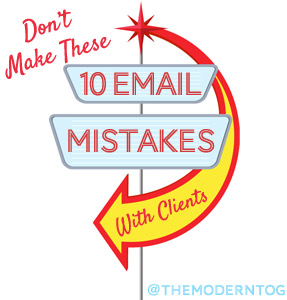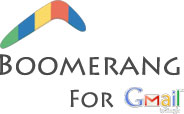

Your emails directly affect how many clients you book.
Really amazing response times and well-written emails can help you book clients by making people talk about how great you were to work with.
However, you can lose clients and garner a lot of negative word-of-mouth advertising if you’re making these 10 common email mistakes with clients.
Let’s jump right in.
1. Sending walls of text
People won’t read really big paragraphs. They simply do not have time. Do your best to make your emails as succinct as possible, or break things up into much smaller chunks.
Confession: I’m guilty of this one all the time, particularly when I’m caffeinated and short on time, and I always kick myself later for it.
2. Being overly emotional or defensive
Sometimes when replying to difficult emails, you come across as far more emotional or defensive than you would if you let yourself cool down for a bit first. Couple this with the fact that people will put whatever tone they want into your emails, often worse than you intend, and it ends up being a very bad combination.
3. Writing like you text
Even though photography is very personal in nature, you are still running a business and need to reflect that in your e-mails. It doesn’t need to be cold and impersonal, but avoid things like “ROFL” and other common texting acronyms.
4. Over-explaining things
While there’s nothing wrong with giving the necessary details, there’s no reason to explain your reasons behind your decisions in many situations.
For example, when a client is asking you if they can schedule a session on Sundays but you reserve this as a day off, simply tell them you’re unavailable that day. There’s no reason to explain that it’s your day off, or that you reserve that for family, or whatever your reasons are. Simply tell them that you are unavailable. When you go into more details, they may try to work around you or convince you otherwise, and there’s no reason to open yourself to this when it isn’t necessary. Other businesses have days and hours of operation, and there’s no reason you can’t either.
5. Showing your insecurities & lack of confidence
There are certain situations, such as right after you raise your prices or add new policies where you may project your own insecurities about it onto your clients.
Writing something like “I know this may feel high to you, but I am willing to work with you” when they never said anything about your pricing being high or having a budget tells them straight up that you don’t believe in your products and pricing and that they can haggle with you. It invites them to take advantage of your lack of confidence and suddenly you’ve got a “difficult client” on your hands that may not have been otherwise.
Be confident. You’ll get more respect from it, even when you are dealing with someone who wants to haggle.
6. Getting too personal
There are times in life where things are just plain hard and you may be later than usual in replying to an email. For example, if you had a miscarriage or some type of illness like the stomach flu that kept you from responding in a timely manner.
While you have a very valid excuse for being late, don’t send them all the details. In fact, I’d keep the response fairly generic and say that you had an unexpected hospital emergency or that you were severely ill instead of getting into all the details. You never know how that person will respond to the details, and unless they ask it is best to keep more generic. You don’t want to trigger depression for someone else who has also miscarried and had a hard time of it by unintentionally bringing up the memory of it again.
7. Sending mail at non-business hours
While this isn’t the end of the world and will show clients that you respond quickly (so there’s some merit to it), you’re now setting a precedence that you are willing to work at any time of the day or night and sets an expectation that you’re always “open” for business.
While there’s nothing wrong with doing work at night (let’s face it – if you have a full-time job you may do ALL your photography work during the evenings and weekends), there’s a simple solution that can help with this.
I highly suggest scheduling your emails to send during regular office hours. I’ve done this in Outlook when working in an office, and I use Boomerang to do this in Gmail and it has transformed how I handle my email.
This way you can write your response at 3am if you want, but schedule it to send at 8am the next morning. Pretty swell.
8. You don’t respond promptly (or at all)
As your business grows, your email inbox will become more difficult to manage. It’s vital to your business to respond as promptly as possible and to not just leave things hanging. Respond within 1 business day whenever possible.
Is your email out of control? You can find relief with my free 7-part series that helps you take control of your email inbox once and for all. It starts off with the very basics, but it moves into truly transformational tips (like letting your inbox sort itself using multiple inboxes) that will save you time and show you how to never forget to follow up with a client again.
9. No direct call to action
We send emails for a reason, and we’re usually looking for a response of some sort.
Make this expectation clear. Tell them what to do next, or give them a call to action.
For example, when I am emailing with a prospective client and they ask me a question, I send them the response and then ask them if they’d like to set up a consultation or if they’d like me to write up the contract for them (the call to action depends on the context we’re in). I could simply answer their question, but by inviting them to take the next step it makes it easy for them to do it right then and there. Simple but effective.
10. Send an email that should have been a phone conversation instead
Some things, particularly very bad news, should be delivered in person or over the phone instead of via email. While it’s good practice to send an email after the fact summing up what you talked about so that you’re both on the same page, use discretion and know when to pick up the phone vs. when to simply send an email.
People don’t always read their emails, so if it’s absolutely essential that they read what you’re sending, call them or meet with them in person.
Need help writing emails?
In a few weeks we’ll be launching our newest guide with over 100 email templates for photographers, ensuring you’ll have a great professional response at your fingertips and keeping you from making critical email mistakes that could lose you clients. It’s live! Check out the Go-To Guide for Client E-mails by clicking here now!
Like this information? Sign up for updates via email to learn more essential photography business tips!


